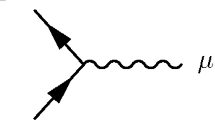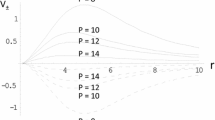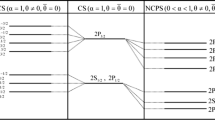Abstract
The general relativistic Dirac equation is formulated in an arbitrary curved space-time using differential forms. These equations are applied to spherically symmetric systems with arbitrary charge and mass. For the case of a black hole (with event horizon) it is shown that the Dirac Hamiltonian is self-adjoint, has essential spectrum the whole real line and no bound states. Although rigorous results are obtained only for a spherically symmetric system, it is argued that, in the presence of any event horizon there will be no bound states. The case of a naked singularity is investigated with the results that the Dirac Hamiltonian is not self-adjoint. The self-adjoint extensions preserving angular momentum are studied and their spectrum is found to consist of an essential spectrum corresponding to that of a free electron plus eigenvalues in the gap (−mc 2, +mc 2). It is shown that, for certain boundary conditions, neutrino bound states exist.
Similar content being viewed by others
References
Brill, D. R., Cohen, J. M.: Cartan frames and the general relativistic Dirac Equation. J. Math. Phys.7, 238 (1966)
Chernoff, P. R.: Essential self-adjointness of powers of generators of hyperbolic equations. J. Funct. Anal.12, 401–414 (1973)
Cohen, J. M., Kegeles, L. S.: Electromagnetic fields in curved spaces: A constructive procedure. Phys. Rev.D10, 1070–1084 (1974)
Dunford, N., Schwartz, J.: Linear operators, Part II. New York: Interscience Publishers 1963
Kato, T.: Perturbation theory for linear operators, New York: Springer 1966
Lichnerowitz, A.: Bull. Soc. Math. France92, 11 (1964)
Rose, M. E.: Relativistic electron theory, New York: John Wiley and Sons 1961
Schroedinger, E.: Commun. Pontif. Acad. Sci.2, 321 (1938)
Schiff, L.: Quantum mechanics New York: McGraw-Hill 1949
Author information
Authors and Affiliations
Additional information
Communicated by B. Simon
Supported in part by the National Science Foundation
Rights and permissions
About this article
Cite this article
Cohen, J.M., Powers, R.T. The general relativistic hydrogen atom. Commun.Math. Phys. 86, 69–86 (1982). https://doi.org/10.1007/BF01205662
Received:
Revised:
Issue Date:
DOI: https://doi.org/10.1007/BF01205662




